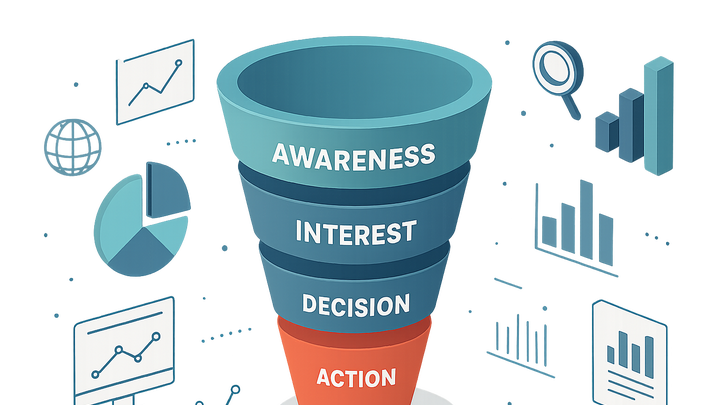Published on 2025-06-26T04:39:15Z
What is the Marketing Funnel? Examples with GA4 and PlainSignal
The marketing funnel is a model that outlines the stages a prospect goes through from initial awareness of a brand to final conversion and beyond. It helps marketers visualize and optimize the customer journey by breaking down the process into distinct phases, such as Awareness, Interest, Decision, and Action. By mapping touchpoints and measuring key performance indicators (KPIs) at each stage, businesses can identify drop-off points and improve campaign effectiveness. Analytics tools measure user activities at each stage, turning the funnel into a data-driven framework for continuous optimization. Platforms like Google Analytics 4 (GA4) leverage an event-based model, while PlainSignal offers a cookie-free, privacy-focused approach—both enabling comprehensive funnel analysis without sacrificing user privacy.
Marketing funnel
A marketing funnel maps customer stages from awareness to conversion, enabling data-driven optimization with tools like GA4 and PlainSignal.
Overview of the Marketing Funnel
The marketing funnel is a conceptual model that breaks down the customer journey into sequential stages. It helps marketers understand where prospects enter, how they interact with content, and where they drop off before converting. By visualizing these stages, teams can strategically tailor messages and allocate resources to drive users toward purchase. Analytics tools measure user activities at each stage, turning the funnel into a data-driven framework for optimization.
-
Awareness
The top of the funnel, where potential customers first discover your brand.
-
Metric: impressions
Total number of times your content is displayed to users.
-
Metric: reach
Number of unique users exposed to your marketing messages.
-
-
Interest
Prospects show interest by engaging with content such as reading blog posts or exploring product pages.
-
Metric: pageviews
Counts how often pages associated with interest are viewed.
-
Metric: bounce rate
Percentage of users who leave after viewing a single page.
-
-
Decision
Users evaluate options and consider making a purchase, often adding items to cart or requesting demos.
-
Metric: add-to-cart events
Tracks when users add products to their shopping cart.
-
Metric: demo requests
Counts how many users request a demo or further information.
-
-
Action
The final stage where a prospect completes the desired conversion action, like a purchase or signup.
-
Metric: conversions
Number of completed desired actions, such as purchases or signups.
-
Metric: conversion rate
Percentage of users who convert compared to the total visitors.
-
Implementing Funnel Tracking with Analytics Tools
Modern analytics platforms like Google Analytics 4 and PlainSignal allow you to configure and analyze marketing funnels without manual data aggregation. By defining funnel steps as custom events or page views, you gain visibility into user progression and drop-off at each stage.
-
Using GA4 for funnel analysis
GA4 features an Exploration tool that supports custom funnel explorations, letting you define steps based on events or page parameters.
-
Step 1: set up events
Ensure key actions (e.g., page_view, add_to_cart, purchase) are sent as GA4 events.
-
Step 2: create a funnel exploration
In the GA4 interface, navigate to Explore > Funnel Exploration and add your defined events as steps.
-
-
Using PlainSignal for funnel tracking
To implement funnel tracking with PlainSignal, insert the following script into the head of your HTML:
<link rel="preconnect" href="//eu.plainsignal.com/" crossorigin /> <script defer data-do="yourwebsitedomain.com" data-id="0GQV1xmtzQQ" data-api="//eu.plainsignal.com" src="//cdn.plainsignal.com/plainsignal-min.js"></script>-
Step 1: add tracking script
Copy the PlainSignal snippet into your site’s <head> to start collecting data.
-
Step 2: configure funnel steps
Use PlainSignal’s dashboard to define each funnel stage by specifying URLs or custom events.
-
Why Marketing Funnel Analytics Matter
Analyzing your marketing funnel provides actionable insights that drive business growth. It highlights where prospects drop off, enabling you to address friction points and streamline the conversion path. Understanding funnel performance across channels helps allocate budget more effectively and tailor content to audience needs.
-
Identify drop-off points
Spot stages with high abandonment rates to prioritize improvements.
-
Optimize marketing spend
Allocate resources to channels and campaigns that excel at each funnel stage.
-
Personalize customer journey
Deliver targeted content based on where users are in the funnel.
Best Practices for Funnel Analysis
Following best practices ensures reliable funnel insights and continuous optimization. Clear definitions, consistent tracking, and regular validation are key to maintaining data integrity and actionable results.
-
Define clear stage criteria
Specify precise conditions or events that mark each funnel stage to avoid ambiguity.
-
Use cohort analysis
Segment users by acquisition source or behavior to uncover deeper patterns over time.
-
Validate data quality
Regularly audit your tracking setup to catch missing events or errors.
-
Iterate with a/b testing
Test changes to content, calls-to-action, or layouts to improve funnel performance.
